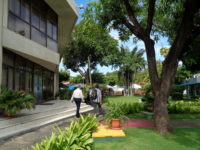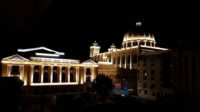In her 1983 novel The Mind-Body Problem, Rebecca Goldstein introduced the notion of “mattering maps,” those mental constructs that all of us create to identify who is important, who “matters.” As her characters explain in the book, who matters depends on what matters. In architecture today, mattering maps are changing. Architects working on affordable housing, social problems, and environmental strategies seem to matter more now. Those who are known mostly for their trademark styles seem to matter less. The changing landscape of architectural importance could be seen at this year’s Mundaneum, a periodic conference organized by Alvaro Rojas and Guillermo Honles, two architects and educators with strong roots in Latin America.
Rojas and Honles have always made sustainability an important part of their agenda, but this year’s conference brought social issues to the forefront with its theme: Necessary Architecture. Instead of splashy designs for office towers or museums, the speakers showed projects that engaged local communities, many of them poor or “informal.” And one speaker, Spanish journalist Llátzer Moix took sharp aim at celebrity architects designing enormous cultural complexes that many cities could ill afford.
During the past 14 years, Rojas and Honles have presented eight iterations of the Mundaneum, originally at the Universidad del Diseño (UniDis) in Costa Rica, the alternative architecture school that Rojas founded in his native country. Honles, who comes from El Salvador originally, practices architecture in Los Angeles, works for the Los Angeles Department of Water and Power, and teaches at the Woodbury School of Architecture. Two years ago, they took their show on the road after Rojas split from UniDis, holding the Mundaneum in Mendoza, Argentina.
This year’s event took place in Granada, Nicaragua, a lovely city founded by the Spanish in 1524 on the edge of Lake Nicaragua. Dotted with plazas, churches, and colonial architecture, Granada poured on the charm. To kick off the conference, the city organized a noisy parade of marching bands and baton-twirling dancers. I can’t say many American cities would have done the same for a two-and-a-half-day event with 18 speakers, three panel discussions, and an audience of about 300 students, teachers, and architects. The talks took place in the church and monastery of San Francisco, an unlikely venue but one that showed off Granada’s rich cultural heritage and offered palm-shaded courtyards for breaks between sessions.
Many of the speakers hailed from Latin America—including Kelton Villavicencio and Javier Salinas (from Nicaragua); Juan Manuel Pelaez and Mauricio Rojas (Colombia); Monica Bertolino (Argentina); Marcelo Ferraz and Jorge Jáuregui (Brazil); and Alberto Pérez-Gómez (Mexico). But others came from further away—Robert Mellin (from Canada); Richard Leplastier, Peter Stutchbury, and Phil Harris (Australia); Thomas Spiegelhalter, Lawrence Scarpa, and myself (United States); and Moix (Spain). Honles, myself, and Kathy MacDonald (editor ofDomus Central America) moderated panel discussions at the end of each day.
Mauricio Rojas (no relation to Alvaro) talked about the need for “an architecture that is humble” and said, “We need to rescue the soul of our cities.” Jáuregui started his talk with a video taken from a helicopter swooping over the dramatic topography of Rio de Janeiro, then showed several of his projects in the city’s favelas. “Architecture needs to be democratic and inclusive,” he said. Later he asked, “How can we help unite a fragmented, divided city?”
Harris, a partner in the Australian firm Troppo, amused everyone with his scruffy, ecologically sensitive projects, one of which was inspired by the cans of a favorite brand of beer. Stutchbury, who studied with and worked for Leplastier before starting his own firm, gave a tag-team presentation with his mentor, showing examples of his graceful houses and talking about the roots of Australian architecture in the culture of the aboriginal people. Leplastier advised the audience to “Use nature as the springboard of your architecture,” because “nature works without excess.”
The biggest applause, ironically, was in response to Moix’s talk, which took architects to task for creating hugely expensive complexes such as the City of the Arts and Sciences in Valencia, Spain (by Santiago Calatrava); the City of Culture in Santiago de Compostela, Spain (Peter Eisenman), and the Barcelona Forum (Herzog & de Meuron). Based on his book Arquitectura Milagrosa (Miraculous Architecture), Moix's talk blamed architects and government officials for spending huge sums of money and contributing to the financial crisis facing Spain today. But Spain actually had governmental surpluses right up to the crisis. What initiated the country's economic catastophe was the bursting of the private sector's real-estate bubble, not overspending by the government. And, frankly, it's hard to blame any architect for accepting the job of designing a major cultural or civic institution.
All in all, though, the Mundaneum’s combination of inspiring projects and cautionary tales proved to be a winning formula—the architectural equivalent of hope and fear.





Post a comment to this article
Report Abusive Comment